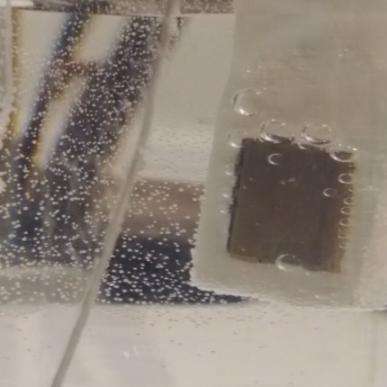Researchers discover new catalysts to generate renewable fuels

For the last seven years, Yale PhD student Staff Sheehan has been working on splitting water. Now, a paper just published in Nature Communications reveals how one of the methods he and his team have uncovered for this process—using a specific iridium species as a water oxidation catalyst—could aid in the development of renewable fuels. The process which Sheehan is investigating is known as artificial photosynthesis—storing energy from the sun as plants do, but more efficiently. "Artificial photosynthesis has been widely researched," Sheehan says, "but water oxidation is the bottleneck—it's usually the most difficult reaction to perform in generating fuel from sunlight." Yale coauthors include Julianne Thomsen, Ulrich Hintermair (currently at the University of Bath), Robert Crabtree, Gary Brudvig, and Charles Schmuttenmaer.
The iridium-based catalyst featured in Nature Communications represents one of two novel methods Sheehan and other Yale researchers have discovered for splitting water in artificial photosynthesis—the other utilizes cobalt. Both have been patented through the Yale Office of Cooperative Research. Sheehan is developing these technologies as a commercial venture through the Yale Entrepreneurial Institute (YEI) under the name Catalytic Innovations along with Aaron Bloomfield, a postdoctoral researcher working jointly at the Center for Green Chemistry and Green Engineering at Yale and the Energy Sciences Institute. The team is working closely with Paul Anastas, the Director of the Center for Green Chemistry and Green Engineering and the Teresa and H. John Heinz III Professor in the Practice of Chemistry for the Environment.
Last summer, Catalytic Innovations participated in the Venture Creation Program at YEI and explored commercial uses for their catalysts outside artificial photosynthesis. Sheehan says working alongside entrepreneurial peers and mentors was a great help in developing their venture. "Our peers and mentors at YEI have been our biggest resource," he says. "Throughout the program, we met people who could offer advice from different backgrounds."
While use in generating renewable fuels remains a long-term goal for Catalytic Innovations, Sheehan says a near-term market opportunity is using their catalysts for metal refining, which takes advantage of the iridium-based catalyst's stability in strong acids. These catalysts can also be used to remediate chemical waste and have military fuel cell applications. The team is successfully raising research and development funds. "What we've discovered is a new architecture for catalysts that is highly efficient and very stable for the eventual development of renewable fuels," Sheehan says.
More information: Nature Communications, dx.doi.org/10.1038/ncomms7469
Journal information: Nature Communications
Provided by Yale University




















